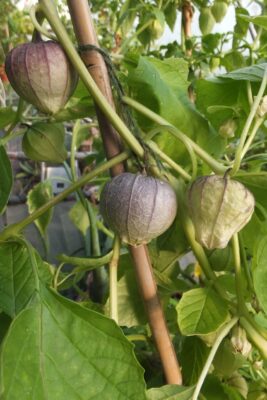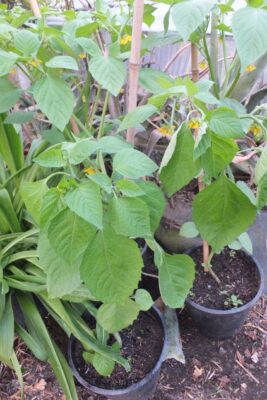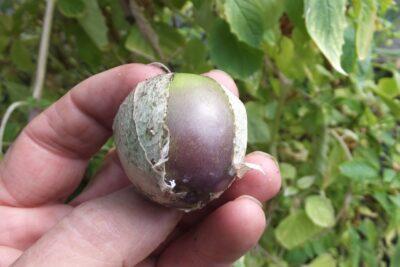
Although greenhouse tomatoes have so far seldom been devastated by Blight to anywhere near the same extent as outdoor crops this seems worryingly on the increase. To say little of wilts, rots and the dreaded Mosaic virus. (Interestingly though Mosaic virus infections have decreased with the decline in smoking ie handling tobacco was the source). Anyway, growing tomatoes is not without potential difficulties though fortunately they’re still wonderfully reliable. Even so it’s prudent to consider a little known alternative considerably more robust seldom suffering tomato’s woes.

Physalis ixocarpa, The Jamberberry, often reduced to Jamberry, aka Tomatillo, was originally the Mexican Husk Tomato. To all intents and purposes this is pretty much a tomato wrapped in a paper case like it’s near cousins the Cape Gooseberry and Chinese Lanern. However a Tomatillo is a much larger fruit, tomato sized, and whereas Cape Gooseberry is mainly eaten fresh or in sweet dishes Physalis ixocarpa is most often wanted for delicious Salsas. Whereas we expect this Mexican dish to be chopped tomatoes originally this was Mexican Husk Tomatoes which are sweeter, tastier, and pleasantly more tart.
Physalis ixocarpa are cultivated varieties of Central American wild P. Philadelphica developed into three strains ripening green, purple and yellow, typically: Toma verde, Purple & Rendidora, newer varieties superseding these though the Purple still’s most widely available.

For many dishes Tomatillos are picked slightly under-ripe not left longer, and green Toma Verde sorts only used fresh as they don’t store. For sweet jams Purple and Rendidora can be left hanging until they’re golden yellow. Now when a Cape Gooseberry is fully ripe the paper case stays intact, the Tomatillo swells so large it splits it’s case. (Easiest removed by immersion in warm water.)
A half hardy annual treated just as a greenhouse tomato this does poorly outdoors. Sow seed, ideally in individual cells in warmth in spring, later sowings give progressively fewer fruits so in summer buy small plants. Pot up and tie the floppy stems to stout canes in the border or large tubs. Growth stops when the sun weakens in late autumn and any remaining fruits ripen best left on with the plants pulled and hung roots and all somewhere airy and frost free.
For the gourmet collector there’s a half dozen Physalis species, mostly annual, with edible berries, a fascinating opportunity for cross breeding.


